|
Posted 5/30/25
VIOLENCE ISN’T DOWN FOR THE COPS
More officers are being murdered. And mostly, with guns.

For Police Issues by Julius (Jay) Wachtel. Sixty-nine of the seventy police departments that comprise the Major Cities Chiefs Association have reported their violent crime counts for 2024.  Consistent with the favorable trend that many cities are bragging about, violence is indeed down. But as our top graphic illustrates, officer safety remains a seemingly intractable issue. According to the FBI’s 2024 LEOKA Special Report, four more officers were feloniously killed in 2024 than in 2023. A substantially larger proportion of the victim officers fell victim to gunfire. Using UCR LEOKA data, here’s a look-back to 2014: Consistent with the favorable trend that many cities are bragging about, violence is indeed down. But as our top graphic illustrates, officer safety remains a seemingly intractable issue. According to the FBI’s 2024 LEOKA Special Report, four more officers were feloniously killed in 2024 than in 2023. A substantially larger proportion of the victim officers fell victim to gunfire. Using UCR LEOKA data, here’s a look-back to 2014:

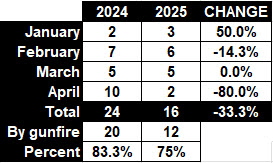 Yet there is some good news. LEOKA’s most recent tally, depicted on the right, reveals that one-third fewer officers were feloniously killed during the first four months of 2025 than during that period in 2024. As one would expect, gunfire remained the predominant cause. LEOKA assigns each episode that leads to an officer fatality to one of eleven categories (Special Report, pg. 3). Here’s how it apportioned the 64 felonious officer killings in 2024 (frequencies in parentheses): Yet there is some good news. LEOKA’s most recent tally, depicted on the right, reveals that one-third fewer officers were feloniously killed during the first four months of 2025 than during that period in 2024. As one would expect, gunfire remained the predominant cause. LEOKA assigns each episode that leads to an officer fatality to one of eleven categories (Special Report, pg. 3). Here’s how it apportioned the 64 felonious officer killings in 2024 (frequencies in parentheses):
Click here for the complete collection of strategy and tactics essays
- Response to unlawful or suspicious activity (14)
- Traffic stop (11)
- Circumstance unknown / not reported (7)
- Follow up investigation (7)
- Tactical situation (7)
- Pursuit (7)
- Check in with another law enforcement officer (4)
- Routine patrol other than traffic stop (3)
- Warrant service (2)
- Medical, mental health, or welfare assistance (1)
- Out of service [court/dining/etc.] (1)
Murders of law enforcement officers draw considerable attention in the media, and their circumstances, including the motives and criminal backgrounds of the killers, are often explored in depth. Drawing from the Officer Down Memorial Page (click here for 2024 and here for 2025) and relevant news accounts, we identified a total of seventeen episodes between January 1-April 30, 2024 and ten during that period in 2025 that involved the intentional, felonious killing of at least one law enforcement officer. Gunfire was responsible for all the deaths but two in 2024 (one of the non-gun deaths was a stabbing, the other involved the violent use of a chain.) Also note that the officers killed count is slightly lower than LEOKA’s. That’s due to our exclusion of officers who died from injuries sustained during earlier periods and from the acts of others, such as crossfire by their colleagues. Here’s an overall look:

And here’s a breakdown by incident type:

Traffic-related episodes were the most frequent. That’s to be expected, as they’re by far the most common enforcement activity. But warrant service also figured prominently. That likely reflects its intrinsically conflicted nature and the characteristics of its “clientele.” According to news accounts, at least nineteen of the twenty-five identified cop killers had substantial arrest histories, and at least seven had one or more felony convictions. Here’s a summary of the episodes in 2025, using categories of our making:
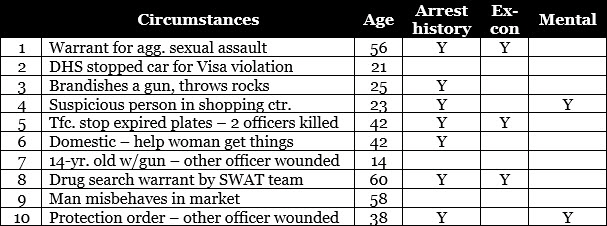
We used the Officer Down Memorial Page and accounts in the media to take a closer look. Here are the incidents in numerical order:
- Brazoria Co., TX Deputy Jesus Vargas was shot and killed while serving a warrant for aggravated sexual assault. His assailant was a repeat violent offender who had served a 20-year prison term. ODMP News account
- Border Patrol agent David Maland stopped a car for a suspected Visa violation. Its occupants, a young woman and a German national, were previously observed attired in tactical clothing. The woman opened fire, killing agent Maland. Her vehicle contained an assortment of guns and tactical gear. ODMP News account
- North Las Vegas police officer Jason Roscow responded to a call about a homeless person brandishing a gun and throwing rocks. As he arrived the man started shooting, and in the exchange of gunfire both were killed. Officer Roscow’s murderer had been convicted of CCW and arrested for various offenses, including resisting an officer and larceny. ODMP News account
- Roswell, GA police officer Jeremy Labonte arrived at a shopping center on a suspicious person call. When approached, the suspect opened fire. Officer Labonte’s killer had been treated for mental issues. He had prior arrests for battery and other crimes and a conviction for unlawfully discharging a weapon. ODMP News account
- Virginia Beach police officers Cameron Girvin and Christopher Reese were murdered by the driver of a car they stopped for an expired license plate. Their killer had served eight years in Federal prison for drug offenses and being an ex-con with a gun. ODMP ODMP News account Prior post
- Hinds Co., MS deputy sergeant Martin Shields, Jr. and a colleague were dispatched to protect a woman as she retrieved belongings from a former residence. Her estranged spouse opened fire as soon as they arrived. Deputy Shields was killed, and the woman and another adult female were wounded. The ex-spouse committed suicide. He had 25 arrests, including 8 for felonies, but no convictions. ODMP News account Prior post
- Newark police dept. sergeant Joseph Azcona and a partner drove up to a reportedly armed 14-year old boy who was amidst a group of teens. Before they could exit their car the youth fired “nearly 30 bullets” from a gun that was apparently converted to full-auto. Sergeant Azcona was killed and his partner was wounded. ODMP News account
- Marysville, CA police officer Osmar Rodarte and other members of a regional SWAT team served a search warrant at the residence of a major drug dealer. They were met by gunfire. Officer Rodarte was fatally wounded. His murderer, a registered sex offender who was prohibited from having guns, was also killed. ODMP News account
- Walton Co., FL deputy sheriff William May responded to a disturbance at a local market. Once he escorted the disorderly person outside, the man pulled a pistol. They exchanged fire, and both were killed. Deputy May’s killer was a CCW permit holder whom police had previously contacted for “minor issues like welfare checks.” ODMP News article
- Columbia Co., GA deputy sheriff Brandon Sikes and three colleagues stopped a vehicle to serve its driver with a domestic violence protection order. Their subject, a diagnosed schizophrenic, opened fire with an “automatic weapon.” Deputy Sikes was killed and a colleague was wounded. Their agency had been alerted that the man had machineguns and pipe bombs, and after the shooting these items were found in his R.V. ODMP News article
None of these episodes was your archetypal “felony in progress” call. But as cops well know, virtually any activity that brings them into contact with chronically non-compliant citizens can erupt into violence. And these ten killers were indeed non-compliant sorts. At least seven had substantial arrest records. At least four had a history of violence. At least three were convicted felons, thus legally barred from having guns. Note those entries about illegal weapons and “tactical gear.” And about a fourteen-year old slinging a machinegun.
Take another glance at the graphs that lead off this essay. Cops haven’t apparently realized the benefits of that “great crime drop.” Alas, in our gun-suffused society, firearms are literally within anyone’s reach (“Where do They Come From?”). And concerted efforts are underway to eliminate the obstacles to gun ownership that do exist. Seven years ago we posted “No one Wants ex-Cons to Have Guns.” Back then the title seemed a reasonably accurate expression of the popular will. Who would have thought that the Supreme Court would in time order a second look at the Federal law that prohibits gun possession by felons convicted of non-violent crimes?
Be sure to check out our homepage and sign up for our newsletter
But put the “whom” aside. Let’s turn to “what”. Perhaps the only factor that can be realistically addressed is the gun. Machineguns, that curse of modern warfare, have been long  illegal for civilians to possess. Inevitably, profit-seeking types developed workarounds. Say, bump stocks, which enable a rate of fire that mimics full-auto. Two years after the 2017 Las Vegas massacre, in which bump stock-equipped rifles were used to murder sixty, ATF classified the devices as illegal machinegun conversion parts. Problem is, Federal law defines machineguns as weapons that fire repeatedly from a single pull of the trigger. illegal for civilians to possess. Inevitably, profit-seeking types developed workarounds. Say, bump stocks, which enable a rate of fire that mimics full-auto. Two years after the 2017 Las Vegas massacre, in which bump stock-equipped rifles were used to murder sixty, ATF classified the devices as illegal machinegun conversion parts. Problem is, Federal law defines machineguns as weapons that fire repeatedly from a single pull of the trigger.  Bump stocks use recoil to repeatedly pull the trigger. That conflict led the Supreme Court to strike down ATF’s ban (Garland v. Cargill, no. 22-976, 6/14/24). (State laws that prohibit bump stocks remain in effect.) So what about ATF’s move against “forced reset triggers,” those newfangled gadgets that accomplish the same ends as bad-old bump stocks? Check out DOJ’s May 16, 2025 announcement: Bump stocks use recoil to repeatedly pull the trigger. That conflict led the Supreme Court to strike down ATF’s ban (Garland v. Cargill, no. 22-976, 6/14/24). (State laws that prohibit bump stocks remain in effect.) So what about ATF’s move against “forced reset triggers,” those newfangled gadgets that accomplish the same ends as bad-old bump stocks? Check out DOJ’s May 16, 2025 announcement:
Today, in accordance with President Trump’s Executive Order Protecting Second Amendment Rights, as well as the Attorney General’s Second Amendment Enforcement Task Force, the Department of Justice announced the settlement of litigation between the federal government and Rare Breed Triggers. “This Department of Justice believes that the 2nd Amendment is not a second-class right,” said Attorney General Pamela Bondi. “And we are glad to end a needless cycle of litigation with a settlement that will enhance public safety.”
Rare Breed Triggers is free to manufacture and sell the devices. But only for use in long guns!
Still want to be a cop? San Francisco’s hiring!
UPDATES (scroll)
7/25/25
Lorain, a Cleveland suburb, has 65,000 residents and its own police force. And it's now in mourning for Officer Phillip Wagner, who
succumbed to wounds sustained when he and Officer Peter Gayle were ambushed as they enjoyed their lunch while parked on a dead-end
street. Their assailant, 28-year old Michael Parker, fired on them with a rifle that was part of an arsenal police later found in
his car. He was killed in the exchange of gunfire; officers Gayle and Brent Payne, who had rushed in to help, were wounded, the latter
critically.
7/16/25 Homicides in L.A. are way down: there were 116 between Jan. 1-June 28 this year, compared with 152 during that period in 2024. But LAPD officers are opening fire substantially more often. This year they've shot 21 citizens and killed nine, compared with 14 shot and 8 killed during the same period in 2024. According to Chief Jim McDonnell, the increase is a consequence of
more persons being armed, with real and fake guns. More officers are also supposedly being assaulted. But his reassurances didn't win over the Police Commission: at least one member remains highly skeptical.
6/3/25 Bloomfield, NM police officer Timothy Ontiveros succumbed to injuries suffered during a vehicle stop on Memorial Day. He had
stopped a car for a traffic violation, but its driver refused to roll down his window or show ID. And when Officer Ontiveros and a partner tried to break in to the
car, Dennis Armenta, 58, opened fire
with a handgun, badly wounding officer Ontiveros. Armenta, who reportedly has past arrests for “assault, trespassing, resisting an officer and threatening
hospital staff,” was shot dead by the other officer on scene.
6/2/25 Baldwin Park, Calif. police officer Samuel Riveros, a nine-year veteran, was killed and his partner was seriously wounded when they arrived in a residential neighborhood to confront a man who was reportedly shooting a rifle in the street. In the exchange of fire the suspect was wounded, and the body of an innocent citizen whom he apparently shot was also discovered. It took place on a Saturday evening as local residents had gathered for social events.
|
Did you enjoy this post? Be sure to explore the homepage and topical index!
Home Top Permalink Print/Save Feedback
RELATED POSTS
Forewarned is Forearmed Loopholes are Lethal (II) Again, Kids Die
“Bump Stocks” Aren’t the (Real) Problem Risky Business Where Do They Come From?
Posted 5/12/25
A LETHAL DISTRACTION
A foot pursuit of hit-and-run suspects turns
into an exchange of fire with an armed resident
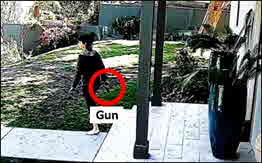
For PoliceIssues by Julius (Jay) Wachtel. We clipped this image from an extensive video compilation that LAPD released one day after its officers exchanged gunfire with (and, fortunately, only lightly wounded) a well-known local resident. We’ll get to the details shortly. But that encounter instantly brought to mind a similar and ultimately far more tragic confrontation. It took place in Hemet, a city of about 90,000 about ninety miles southeast of Los Angeles, about two years ago. In that episode, which we examined in “When Worlds Collide,” a police officer shot and killed a homeowner who was also in their own yard, and also carrying a gun. And no, he never fired it.
Back to Eagle Rock. That’s the prosperous Northeast Los Angeles neighborhood where novelist Jillian Lauren resides with her husband, musician Scott Shriner and their two small children. About three in the afternoon on Tuesday, April 8 she and (reportedly) her kids and a babysitter were in the family’s detached, single-family residence when a police helicopter began hovering overhead. It was helping LAPD and California Highway Patrol officers scour the neighborhood for three male adults who had just fled the scene of a traffic accident. Here’s a sequence of stills we clipped from the video:
Click here for the complete collection of strategy and tactics essays

A fixed surveillance camera depicts an absconder coursing through the perimeter of one of the upscale homes that line the street. Directed by residents, officers chase after the man. The cops wind up in the home’s elaborate rear patio, their quarry nowhere in sight. A tall, tightly constructed fence lines the back of the property. As it turns out, it abuts the rear yard of Ms. Lauren’s home. While the chopper’s rotor blades noisily whirl overhead, the officers peer over the fence. But instead of the bad guy (he’s soon caught nearby) they spot Ms. Lauren walking around. She’s gripping a gun.

Yelling over the fence, the officers identify themselves and order Ms. Lauren to drop the gun (the video uses her husband’s last name, “Shriner.”) But she doesn’t. And as the cops train their guns on

Ms. Lauren (left image), she fires a single shot (second image). Their return fire wounds her in the arm. It also kicks up a cloud of dust (third image). (Click here for a brief video clip of the shooting.) Ms. Lauren promptly retreats into her home. Check out those time captions: from initial warnings to “shots fired” took all of two minutes. Nearly an hour would pass before Ms. Lauren came out and surrendered.
LAPD’s official take on things, set out in its April 10 news release, is that “officers ordered Shriner (again, her husband’s name) to drop the handgun numerous times; however, she refused.” Ms. Lauren was arrested for attempted murder of a peace officer and released on bond. Her 9mm. pistol was recovered, along with a spent cartridge. Her next court date is May 13. That’s when prosecutors are expected to proffer formal charges.
 That will undoubtedly present a challenge. Clearly, That will undoubtedly present a challenge. Clearly, Ms. Lauren did shoot at the cops. But why is far from settled. While the officers’ commandments are audible on bodycam footage, Ms. Lauren wasn’t carrying a police radio, and helicopter noise may have kept her from understanding what was being yelled. That tall fence that got in the cops’ way (see images) obstructed her view as well. Given Ms. Lauren’s rattled outlook, she likely assumed that the men who were pointing guns and barking orders were the bad guys who got chased into her neighborhood. Ms. Lauren did shoot at the cops. But why is far from settled. While the officers’ commandments are audible on bodycam footage, Ms. Lauren wasn’t carrying a police radio, and helicopter noise may have kept her from understanding what was being yelled. That tall fence that got in the cops’ way (see images) obstructed her view as well. Given Ms. Lauren’s rattled outlook, she likely assumed that the men who were pointing guns and barking orders were the bad guys who got chased into her neighborhood.
That’s not just idle speculation. Listen to the 911 call that closes out LAPD’s video compilation. According to the narrator, LAPD Capt. Alex Chogyoji, the call came in shortly after the shooting. It features three voices: the dispatcher’s, a female caller (whom we assume is Ms. Lauren’s babysitter), and a woman with the caller (most likely, Ms. Lauren.) Here’s our transcript:
- Caller: Oh, there were three men, she says, there were three men, and one of them shot her and the cops are looking for him right now. They have their guns out. And like, I don’t know if they found him yet or not, but they told me to not look out the window so, I’m not looking out.
- 911: Okay. So, he’s not in your yard? You don’t know that he’s there?
- Caller: Well, he was in my yard because that’s where he shot her.
- 911: Oh, okay.
- Caller: He shot from the other side…he shot from the other side of the gate.
- 911: Okay.
- Caller’s companion: Other side. He was…I had my gun…And he said put down that gun, put down that gun. I said put down your fucking gun…And then he shot me.
- Caller: Okay. That’s what happened I guess.
- Caller’s companion: I had a gun…
- 911: So, you guys don’t know where he went?
- Caller (to companion): Okay babe, just please breathe, okay?
- Caller (to 911): Okay, how long do you think until someone can be here?
- 911: Well, the officers are looking for this man. That’s why I’m asking if you…do you know where he went?
- Caller: I have no idea where he went…
- Caller (to companion): Where was he when you…when you got shot?
- Caller’s companion: He was out. There are three men out at the other side of this fence here…
Upper-crust neighborhoods such as Ms. Lauren’s are festooned with security cameras. That’s where much of LAPD’s video compilation originated. When cops arrived, Eagle Rock residents quickly pointed them in the direction where a bad guy fled. Officers shouldn’t have been surprised to find citizens patrolling their yards. Yet Ms. Lauren was packing a gun. That might have been a bit discomfiting.
Switch perspectives. Ms. Lauren knew that hoodlums were on the loose. Strangers were now peering over her fence, waving pistols. Might they be cops? That’s unlikely. Why would police be after her?
Given the officers’ lack of visibility and the whap-whap-whap of the helicopter rotors, verbal commands might not have sufficed. Our related posts (see below) are replete with examples of the tragic officer-citizen misunderstandings that can accompany the chaos of the streets. In Hemet (“When Worlds Collide”) a resident called police to report a theft from his home. Officers looked in his backyard, but the thief was gone. So two cops went around the block to check the yard of the opposing home. But its resident, Christian Drye, a father of five, said he’d do it himself, thank you. And when he grabbed a gun and stepped outside (shadows of Ms. Lauren), an officer who remained at the original caller’s home took him for being the bad guy. And shot an impulsive but well-meaning homeowner dead.
Be sure to check out our homepage and sign up for our newsletter
Keeping one’s distance may seem to run counter to the police mission. But there is sometimes no alternative. That’s not just our opinion. Former Grand Rapids, Michigan police officer Christopher Schurr was recently tried for murdering Patrick Lyoya, whom he had stopped for a traffic violation (“Tenacity is Great – Until it’s Not”). Lyoya, who was unlicensed, drunk and had a domestic violence warrant, bolted. Schurr caught up, and during a violent struggle Lyoya grabbed the officer’s Taser. So the cop shot him dead. Use-of-force experts lined up on both sides. While defense experts called the shooting justified, Schurr had already discharged both of his Taser’s cartridges. Squeezing its trigger would presumably have no effect. According to prosecution expert Seth Stoughton, the “imminent threat of death or great bodily harm” that justifies deadly force was accordingly absent. In his opinion, Mr. Lyola should have been let go, and arrested later.
That case just ended in a mistrial. So back to “square one.” Is there a solution? As we recently suggested in “Putting Things Off,” there are good reasons why cops prefer not to delay arrests. On the other hand, as “Backing Off” points out, sometimes the only realistic preventive may be to not intervene. We’ll soon see how the criminal justice system handles Ms. Lauren’s problematic situation. Stay tuned!
UPDATES (scroll)
5/14/25 Making her initial court appearance, Jillian Lauren pled not guilty to two felony charges: discharging a firearm in a grossly negligent manner, and assault with a semi-automatic firearm. She is not being prosecuted on the arrest charge, attempted murder of a peace officer. Her maximum penalty if convicted on both charges is nineteen years in prison. A preliminary hearing is set for June.
|
Did you enjoy this post? Be sure to explore the homepage and topical index!
Home Top Permalink Print/Save Feedback
RELATED POSTS
Putting Things Off When Worlds Collide What Cops Face Tenacity is Great - Until it’s Not
Backing Off Routinely Chaotic Three In(?)explicable Shootings
Posted 4/26/25
PUTTING THINGS OFF
Pursuits hurt and kill innocents. What are the options?

For Police Issues by Julius (Jay) Wachtel. As police pursuits go, it’s an appallingly familiar scene. Two vehicles lie shattered after their violent collision at an urban intersection. On the right, a white Nissan that a fleeing thief assertedly drove at “nearly 90 miles per hour” on city streets. On the left, the blue BMW occupied by his victim, Marianne Mildred Casey, 67. She didn’t survive the crash.
Why was Anthony Michael Hanzal running from police? His reason has a familiar ring. An undercover cop observed the “second-striker” shoplift “boxes of Legos” at a grocery store. A black-and-white was called in. High on drugs, and with two prior convictions for theft (Orange County Superior Court cases 19HMO1127 and 23NM11569), when those red lights started flashing the chronic thief and drug abuser probably feared that it was indeed “game over.”
Click here for the complete collection of strategy and tactics essays
Coincidentally, his life-changing behavior took place on the very day – December 18, 2024 – that California Proposition 36 took effect. Enacted due to widespread disgust over the thievery and shoplifting that beset retailers, it made a third conviction for a misdemeanor property offense a “wobbler” punishable as a felony. Whether Hanzal knew of the toughening hasn’t been said. Bolting from the cops, he promptly rear-ended another car and hopped on the freeway. An extensive, high-speed pursuit by multiple agencies wound up back on city streets. Hanzal soon ran a red light and struck an innocent car, killing its elderly driver (photo above).
Hanzal was charged with gross vehicular manslaughter while intoxicated, evading a peace officer causing death, and theft with two prior convictions. (Orange County Superior Court case# 24NF3264.) He pled not guilty; trial is pending.
Hanzal’s pursuit was your stereotypical, “all hands on deck” police chase. (Click here for the ABC News story and video.) Police lost his trail several times, but “backing off” – that, by the way, is the title of one of our posts – was obviously not in the cards.
Two days after that tragic ending came the arraignment, in the same court system, of another Southern California evildoer. On December 20, 2024 a “documented White Supremacist gang member with six prior strikes” appeared in Orange County Superior Court to answer for six felonies, ranging from evading a police officer to murder (case# 24WF3411). According to the D.A.’s press release, Timothy Bradford Cole II, 43, fled from police after torching the home of his sister’s fiancée. Cole was supposedly retaliating against his sister, whose call to child protective services allegedly caused him to lose custody of his kids.
 Cole set the fire by dousing the home’s shrubbery with an accelerant. When cops arrived, he took off. Officers promptly set chase. But they didn’t have to go very far. Traveling at an estimated speed of 90 mph, Cole soon ran a red light and smashed into a BMW occupied by three innocents. One passenger, a 25-year old Vietnamese foreign exchange student, was killed. (For NBC L.A.’s comprehensive account click here.) Cole set the fire by dousing the home’s shrubbery with an accelerant. When cops arrived, he took off. Officers promptly set chase. But they didn’t have to go very far. Traveling at an estimated speed of 90 mph, Cole soon ran a red light and smashed into a BMW occupied by three innocents. One passenger, a 25-year old Vietnamese foreign exchange student, was killed. (For NBC L.A.’s comprehensive account click here.)
It’s not just Orange County. Police pursuits are commonplace throughout Southern California. L.A.’s FOX News 13 offers an online chronicle of notable local chases by the CHP and local police (its earliest posted account is of a pursuit on April 4, 2019.) We selected pursuits between April 1, 2024 and March 31, 2025. Keeping in mind the entries’ limited scope and accuracy, they do offer insights into episodes that seemed particularly newsworthy. Here’s a brief overview:
- FOX lists 139 chases over those twelve months. A dozen involved trucks and buses (nearly all had been stolen.) Eight involved motorcyclists. Thirteen of the fleeing vehicles – including a motorcycle – were clocked at speeds exceeding 100 mph.
- Many pursuits weren’t prompted by traffic infractions. Nine involved carjackings. Thirty-two were of reportedly stolen vehicles. In one notorious example, a stolen car occupied by four youths, ages 12-14, crashed while being pursued by sheriff’s deputies. Each child was seriously injured; two, critically.
- At least twenty-one fleeing motorists were wanted for a recent crime. Several were armed (one reportedly had a stockpile of guns). Four encounters ended in gun battles; one suspect was killed. No innocent persons or officers were reportedly wounded or killed.
- Sixteen chases involved or ended in collisions between fleeing cars and innocent motorists. Six fleeing vehicles collided with police cars. Several crashed into buildings, abutments and other fixed obstacles.
- Virtually every crash produced injuries. Five occupants of the vehicles being pursued were killed. Four innocent persons also died: three were motorists; one was a bicyclist. In that episode, LAPD officers had been trying to stop a man who burglarized a parked car. During a brief, high-speed

chase the suspect’s vehicle struck a bicycle. It then collided with several other cars and flipped over. A small tent (pictured) was erected where the cyclist lay.
Ill-fated chases don’t only beset Southern California. Updates in “Is it When to Chase? Or If?” chronicle a host of pursuits with tragic outcomes. This March a pedestrian and two occupants of innocent vehicles were killed when struck by cars being pursued by Hyattsville, MD police. In January, an officer in a small Mississippi town chased an SUV beyond his city’s limits. That vehicle soon crashed into another; the SUV’s driver and both occupants of the car it struck were killed.
Policies that govern pursuits vary widely across the U.S. Our local major agency, LAPD, has a relatively permissive approach. Here’s an extract from its current manual:
555.10 INITIATION OF A VEHICLE PURSUIT. Officers shall not initiate a pursuit based only on an infraction, misdemeanor evading (including failure to yield), or reckless driving in response to enforcement action taken by Department personnel.
Officers may pursue felons and misdemeanants, including law violators who exhibit behaviors of illegally driving under the influence of drugs or alcohol. If reasonable suspicion or probable cause exists that a misdemeanor (with the exception of misdemeanor evading or reckless driving in response to enforcement action by Department personnel) or felony has occurred, is occurring or is about to occur, employees may pursue a suspect vehicle.
At the start, officers are cautioned against prodding motorists to flee (the phrasing is nearly impenetrable, but its intent seems clear.) Chases are otherwise allowed when there is “reasonable suspicion” that a crime – felony or misdemeanor – was committed or seems “about to occur.” Ordinary traffic offenses such as speeding and expired registration are only “infractions,” thus off the table. DUI, reckless driving and hit-and-run, though, are misdemeanors. Ditto shoplifting, petty theft and all assaults. So for those, the chase is on!
But even LAPD has its limits. Those are buried in yet another volume of its massive manual:
205.17 CONTINUATION/TERMINATION OF THE PURSUIT. Officers involved in a pursuit shall continually evaluate the necessity for continuing the pursuit. Officers must determine whether the seriousness of the initial violation or any subsequent violations reasonably warrants continuance of the pursuit.
That “evaluation” comprises thirteen factors. Here are the first four:
- Whether there is an unreasonable risk of injury to the public's safety, the pursuing officers' safety or the safety of the occupant(s) in the fleeing vehicle
- Whether speeds dangerously exceed the normal flow of traffic
- Whether vehicular and/or pedestrian traffic safety is unreasonably compromised
- Whether the suspects can be apprehended at a later time
A seemingly fundamental reason for chasing – “The seriousness of the crime and its relationship to community safety” – is in seventh place.
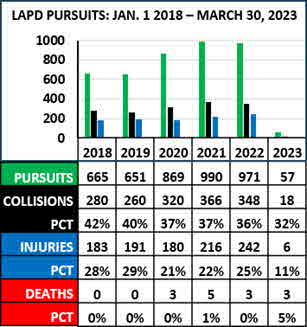 As it turns out, in L.A. (and seemingly, across the U.S.) the primary justification for conducting a chase is that the vehicle being pursued was reportedly stolen. According to LAPD, that was the reason for 44% (1,862 of 4,203) of its chases between January 1, 2018 and March 30, 2023. Drunk driving (17%) placed a distant second and reckless driving (11%) came in third. Violent crimes were further down. ADW (6%) was fourth; carjack/robbery (5.7%) was fifth. LAPD also reported that 38% of pursuits (1,592) resulted in a collision. Of these, 1,032 (65%) caused injury or death. Check out our graphic. Between 36%-42% of LAPD pursuits conducted during full-year periods ended in a crash. Using pursuits instead of crashes as a basis, between 25%-29% ended with a crash-related death. And as one would expect, as the number of pursuits increased, their overall consequences worsened. As it turns out, in L.A. (and seemingly, across the U.S.) the primary justification for conducting a chase is that the vehicle being pursued was reportedly stolen. According to LAPD, that was the reason for 44% (1,862 of 4,203) of its chases between January 1, 2018 and March 30, 2023. Drunk driving (17%) placed a distant second and reckless driving (11%) came in third. Violent crimes were further down. ADW (6%) was fourth; carjack/robbery (5.7%) was fifth. LAPD also reported that 38% of pursuits (1,592) resulted in a collision. Of these, 1,032 (65%) caused injury or death. Check out our graphic. Between 36%-42% of LAPD pursuits conducted during full-year periods ended in a crash. Using pursuits instead of crashes as a basis, between 25%-29% ended with a crash-related death. And as one would expect, as the number of pursuits increased, their overall consequences worsened.
Those “consequences” aren’t just a problem in L.A. According to The City, a major nonprofit news outlet that monitors doings in the Big Apple, N.Y.P.D. pursuits soared in December 2022 when John Chell took over as chief of patrol. Thanks to an aggressive anti-crime approach, pursuits jumped from 32 to 53, then “surged” to 133 one month later. But in January 2025 newly-installed Police Commissioner Jessica Tisch (literally) slammed on the brakes. Her decision to restrict chases to instances that involved “suspected felonies or violent misdemeanors” was likely influenced by a profusion of pursuit-related crashes, with “more than one a day” during the preceding year.
Data collected by NHTSA, America’s highway safety agency, confirms that the consequences of pursuits haven’t only beset L.A. and New York City. (Caveat: NHTSA crash data is incomplete. For example, between 2009-2023, “fatal crashes with pursuits” and “persons killed in fatal crashes with pursuits” lacked entries for L.A. in 2016 and 2018, and for N.Y.C. in 2016, 2017, and 2019-2021.) Keeping such glitches in mind, we assembled a graphic overview:
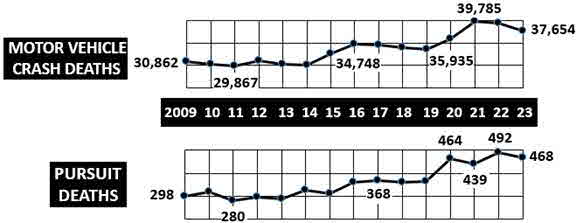
In 2020 pursuit deaths reached a then-historical high of 464. One year later, the toll was “only” 439. That improvement is consistent with the more restrictive chase policies that accompanied the kinder and gentler approach to policing that was brought on by the 2020 murder of George Floyd. But only one year after that, pursuit deaths reached a new high of 492. What happened? Last April Stateline published an account that suggests the Floyd imbroglio caused many jurisdictions to implement restrictive pursuit policies. But the increase in crime that soon followed led agencies that had tightened the reins on cops to reverse course. That “reversal” happened in even the “Bluest” of places. Say, the District of Columbia and San Francisco:
In the District, officers will be able to begin pursuits if vehicle occupants pose an imminent threat to others. And in San Francisco, officers can initiate pursuits for any felony or “violent misdemeanors, including retail theft, vehicle theft and auto burglaries.”
Are pursuits worth their costs? Two years ago DOJ’s COPS office issued a comprehensive 146-page report that analyzed pursuit policies across the U.S. “Vehicular Pursuits – A Guide For Law Enforcement Executives in Managing the Associated Risks” closed by endorsing a standard that would require “having reasonable suspicion that the suspect is wanted for a violent crime and presents an imminent threat to the community.” That’s far, far more restrictive than L.A.’s policy. Really, if this approach is used, pursuits would rarely take place.
So what does the IACP think? America’s premier organization of police executives issued a guide in 2019. However, it’s only intended to help agencies develop pursuit policies – it offers no specific recommendations of its own. However, we came across an IACP “model” vehicular pursuit policy dated December, 2015. It’s not on their website, but it seems genuine. Here’s a brief outtake:
Be sure to check out our homepage and sign up for our newsletter
…Pursuit is authorized only if the officer has a reasonable belief that the suspect, if allowed to flee, would present a danger to human life or cause serious injury. In general, pursuits for minor violations are discouraged…Unless a greater hazard would result, a pursuit should not be undertaken if the subject(s) can be identified with enough certainty that they can be apprehended at a later time....
That second sentence really caught our eye. Officers face that “unless a greater hazard would result” conundrum whenever someone flees, or acts as though they might. To be sure, arresting a “not-so-model citizen” is always risky. But abandoning a chase places evildoers on notice and gives them an opportunity to prepare for the Mounties to arrive. Setting up to make an ostensibly safer snatch can also consume prodigious amounts of police time and resources. Meanwhile a potentially dangerous person remains free to run around and misbehave.
Bottom line: there is good reason why officers nearly always prefer to hook someone up when the opportunity first presents itself. To make that task safer, “Forewarned is Forearmed” recently recommended that police deploy advanced technologies so that cops can be instantly informed about the criminal backgrounds of persons they encounter. Still, there is a balancing act. Pursuits do hurt and kill innocents. So in policing, as elsewhere, “putting things off” is sometimes called for. But it’s not always the best choice.
UPDATES (scroll)
5/28/25 Five years ago Oakland PD started prohibiting officers from exceeding 50 mph during a pursuit without special permission. According to a member of the city’s Chinatown Improvement Council, that’s only encouraged prospective evildoers to do their foul deeds in Oakland. Police chief Floyd Mitchell has asked the police commission to do away with the restriction, and the officer union is fully on board. But the Anti-Police Terror Project calls the proposal a “knee-jerk reaction” that will only lead to more incidents such the recent death of an Oakland woman who was struck by a car being chased by the CHP.
5/12/25 Until recently Aurora (CO) police could only pursue drunk drivers or persons who committed a felony and presented “a serious risk to public safety.” On March 5th., the authority to pursue was extended to include all gun-related crimes and stolen vehicles. Since then, Aurora cops have chased 27 stolen cars. So far there’s only been one injury, to a fleeing driver. Most of those arrested had “prolific” criminal pasts. None of the pursuits have gone over five minutes; those that hit this limit were ended.
5/7/25 Police pursuits in Hawaii have often harmed innocent persons. Many resulted in lawsuits and large settlements. One analysis said a third ended in collisions and nearly half caused injuries. But Hawaii’s Law Enforcement Standards Board is yet to create a statewide policy. So legislators have stepped in with a detailed bill. Its current version would, among other things, require that officers only pursue when they believe a person “is attempting to commit, has committed, or is committing a crime” and “poses a serious risk of harm to others.” Police groups and the A.G. oppose the measure.
|
Did you enjoy this post? Be sure to explore the homepage and topical index!
Home Top Permalink Print/Save Feedback
RELATED POSTS
Craft of Policing special topic
A Lethal Distraction Forewarned is Forearmed Backing Off Want Happy Endings? Don’t Chase
Is it When to Chase? Or if?
Posted 3/19/25
FOREWARNED IS FOREARMED
Killings of police officers seem inevitable. What might help?
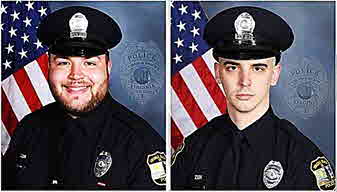
For Police Issues by Julius (Jay) Wachtel. Let’s begin with a slightly edited extract from Police Chief Paul Neudigate’s account of the tragedy that befell his agency and the greater Virginia Beach community on Friday evening, February 21, 2025:
…Last night officers Girvin and Reese…observed a blue Hyundai Sonata with an expired plate. They attempted to stop this vehicle [but] the vehicle failed to yield. They followed the vehicle…It came to a stop at the dead end of Silven Court. Both officers approached the vehicle. The male driver was immediately argumentative [and] refused to exit…They made numerous requests for him to exit. At some point he complied [and] stepped out…Almost immediately there was a tussle...While that tussle was occurring this individual pulled a pistol from his pocket and immediately shot both officers…Those officers fell to the ground. While [they lay] on the ground defenseless he shot them each a second time….
Our lead graphic depicts the late Virginia Beach police officers Cameron Girvin (left photo) and Christopher Reese (right photo). They’re the heroes. As for their assailant, 41-year old local resident John Lee McCoy III, he entered a nearby shed and committed suicide.
Click here for the complete collection of strategy and tactics essays
Both officers were relative newcomers to the force. Officer Reese, a former Sheriff’s deputy, was hired in 2022, and Officer Girvin joined the agency in 2020. Neither one knew McCoy. Neither had they been alerted that the man they stopped for a traffic infraction had a history of violence and gun misuse. Here’s the criminal record we assembled from Virginia State and Federal Court websites:
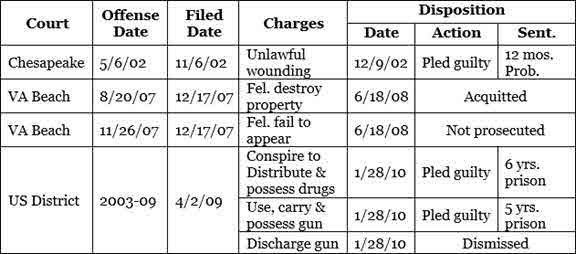
Note that 2002 “unlawful wounding,” a felony offense that Virginia law defines as “shooting, stabbing, etc., with intent to maim, kill, etc.” That episode ended with a misdemeanor plea (case no. CR 02003662.) It was followed, five years later, by a property destruction charge, of which he was acquitted. Two years later came the Feds. On January 28, 2010 John Lee McCoy III, aka “J-Mac” and “T-Mac”, then a youthful 26, pled guilty in Norfolk, Virginia Federal Court to drug and gun violations (Case No.2:09cr42.) According to the record, since 2003 McCoy and his brother had participated in a long-term, wide-ranging drug trafficking enterprise that distributed large quantities of cocaine, marijuana and heroin. A “Statement of Facts” filed in support of his guilty plea to the Federal charges, which McCoy endorsed as correct, sets out a disturbing history of gun use (and misuse):
- In 2005 McCoy bought a .357 cal. revolver and paid for a shooting range membership. He then applied for a CCW permit.
- In 2006 McCoy “shot a man in the face and neck” as payback for a “burglary” (actually, a theft of drugs) from his brother’s residence. Best we can tell, this episode, which drew coverage in the local media and supposedly led to a warrant for “aggravated malicious wounding” was apparently never prosecuted.
- In March 2009 McCoy bought a 12-gauge shotgun and a .45 caliber pistol. He was packing that pistol when arrested one month later on Federal charges. A search of his residence turned up a 12 gauge shotgun, another .45 caliber pistol with an obliterated serial number, a .38 caliber revolver, and $4,500 in cash.
McCoy’s run-in with the Feds landed him in prison. He drew eleven years – six for distributing drugs and five for being armed – to be followed by five years of supervised release. But McCoy got a couple of breaks. He was paroled in December 2017 after serving eight years. Two years later, in November 2019, his supervising agent certified that McCoy “has complied with the rules and regulations of supervised release and is no longer in need of supervision.” Three years before his term of supervision was set to end, the 44-year old ex-con was a completely “free” man.
His final encounter came about five years later.

A few hours after the murder of officers Girvin and Reese a like tragedy befell a small Pennsylvania community. On Saturday morning, February 22, 2025 a gunman took hostages in a hospital ICU, then opened fire when West York Borough police officers arrived. Officer Andrew Duarte (pictured above) was killed, and two other officers and three hospital workers were wounded. Diogenes Archangel-Ortiz, the 49-year old gunman, was shot dead.
What brought him to the hospital? After learning that the woman he loved “was gone,” Archangel-Ortiz apparently intended to confront the staff members who had “failed” him. According to a former girlfriend, the bad news had landed in the lap of a chronically depressed man. And according to York County criminal records, one who was physically aggressive as well. Here’s the summary we compiled from the York County Court portal:

Archangel-Ortiz had been prosecuted for three crimes: leaving the scene of an accident, simple assault, and physical harassment. He pled guilty to each, then repeatedly failed to comply with his conditions of release. His most recent criminal charge, “physical harassment,” apparently stemmed from an incident in which he struck a woman – we assume, the former girlfriend – with a wine glass, and the contempt charges reflect his failure to obey a restraining order that was intended to keep him away.
McCoy and Archangel-Ortiz were coming from different “places.” McCoy, a convicted felon, was probably anxious about being caught with a gun, as that would likely lead to his re-imprisonment. On the other hand, Archangel-Ortiz was acting out his inner demons, and the officers got in the way.
Might these tragic outcomes have been avoided?
Despite decades of strategizing and rule-making (see, for example, “A Not-So-Magnificent Obsession”) there are few real preventives for situations such as those faced by the officers who responded to the hospital. Tactical units have to be assembled, and given the immediate, lethal threat that Archangel-Ortiz posed, that highly vaunted “de-escalation” approach (we wrote about it here) may have been out of reach.
On the other hand, there seemed to be no pressing need to stop the car in Virginia Beach. Post-Floyd pressures to keep cops from needlessly tangling with citizens have led many agencies to prohibit traffic stops for pretextual reasons or for minor transgressions such as expired tags. Here, for example, is LAPD’s policy, dated March 9, 2022:
Use of Traffic/Pedestrian Stops - General. Traffic or pedestrian stops made for the sole purpose of enforcing the Vehicle Code or other codes are intended to protect public safety. Therefore, officers should make stops for minor equipment violations or other infractions only when the officer believes that such a violation or infraction significantly interferes with public safety.
Yet there is a trade-off. Not stopping McCoy would have allowed an ex-con who had once shot someone “in the face and neck” to keep packing (and misusing) a gun.
Be sure to check out our homepage and sign up for our newsletter
Back to square one. Is there a way to enhance officer safety during self-initiated encounters (i.e., Virginia Beach) and dispatched calls (i.e., West York)? Perhaps. Artificial intelligence (AI) has promised to revolutionize policing. While we think its potential is overblown – and that its risks are real – A.I. is being used to develop place-based crime solutions, generate investigative leads, and even dispatch non-emergency calls using “chatbots.” So let’s extend that vision. Might things have turned out differently had dispatchers been able to instantly scan consumer, motor vehicle and criminal databases and compare the results? Once alerted that McCoy and Archangel-Ortiz likely had serious criminal records, the officers would have probably called in additional units and handled the encounters in a more cautious, tactical fashion.

As it turns out, that capability could have prevented a like, tragic outcome on the very next day. After we finished writing the original piece we learned that on February 23, 2025 Hinds County, Mississippi Deputy Sergeant Martin Shields, Jr. (pictured above) was shot and killed while responding to a domestic disturbance. According to the Officer Down Memorial Page, a 42-year old man with a “lengthy criminal history” (reportedly, seven felony and eighteen misdemeanor arrests) opened fire when the deputy arrived. Eric Brown also shot and wounded his wife and another woman when they tried to flee, then committed suicide.
Full stop. In “Our Never Ending American Tragedy” we emphasized that lawmaking was not the ultimate solution. As firearms continue flooding the streets – we’re now beset with unserialized “ghost” guns – policing has become increasingly risky. Indeed, firearm mortality rates for most U.S. States are reportedly similar to those of countries “experiencing active conflict.” So forewarning officers about the criminal records of their antagonists seems an obvious step. Yes, the tip-offs could be incorrect. Yes, officers might over-react. But other than simply pulling cops back, it’s really all we have left.
UPDATES (scroll)
7/18/25 Twenty hours a day, analysts assigned to Seattle P.D.'s "Real Time Crime Center" examine surveillance camera footage
from around the city. And when a feed seems pertinent, it's promptly relayed to patrol and detectives. That's happened six-hundred times
in the unit's first two months of operation. Mayor Bruce Harrell calls it a "game changer."
6/27/25 As agencies around the country have discovered, drones can alert street cops of lurking dangers and other critical information while they’re enroute to a call. With that in mind, the Los Angeles Police Commission, LAPD’s civilian overseers, has loosened rules that restricted the use of drones to barricaded suspects and such. In the future they can be deployed on any “call for service.” They’ll also be available for observing mass events. Tracking lawful demonstrators, though, is forbidden.
5/1/25 According to York County, Pa. D.A. Tim Barker, an investigation into the February 2025 hospital attack by Diogenes Archangel-Ortiz revealed that West York police officer Andrew W. Duarte was struck and killed by projectiles discharged from a shotgun fired by a colleague. These rounds also wounded another officer. Police had tried to de-escalate the encounter, and D.A. Barker called the response - Archangel-Ortiz was shot dead - “100% justified and legally appropriate.”
4/14/25 Approved last year, San Francisco Prop. E authorized police to deploy high-tech tools such as drones and license plate readers. SFPD promptly established a “Real Time Information Center” (RTIC) “where teams of analysts monitor live surveillance feeds, license plate readers, and drone footage” to helps officers promptly respond to calls and solve crimes. Chief Bill Scott credits the RTIC for the city’s substantial drop in crime. But skeptics worry about the technology’s effects on civil liberties.
|
Did you enjoy this post? Be sure to explore the homepage and topical index!
Home Top Permalink Print/Save Feedback
RELATED WEBSITES AND REPORTS
National Institute of Justice - Artificial Intelligence Using A.I. to Address Criminal Justice Needs
Comparing Deaths from Gun Violence in the U.S. with Other Countries
RELATED POSTS
Violence Isn’t Down for the Cops Putting Things Off Our Never Ending American Tragedy
Backing Off R.I.P. Proactive Policing? A Not-So-Magnificent Obsession Routinely chaotic
Preventing Mass Murder De-escalation
|